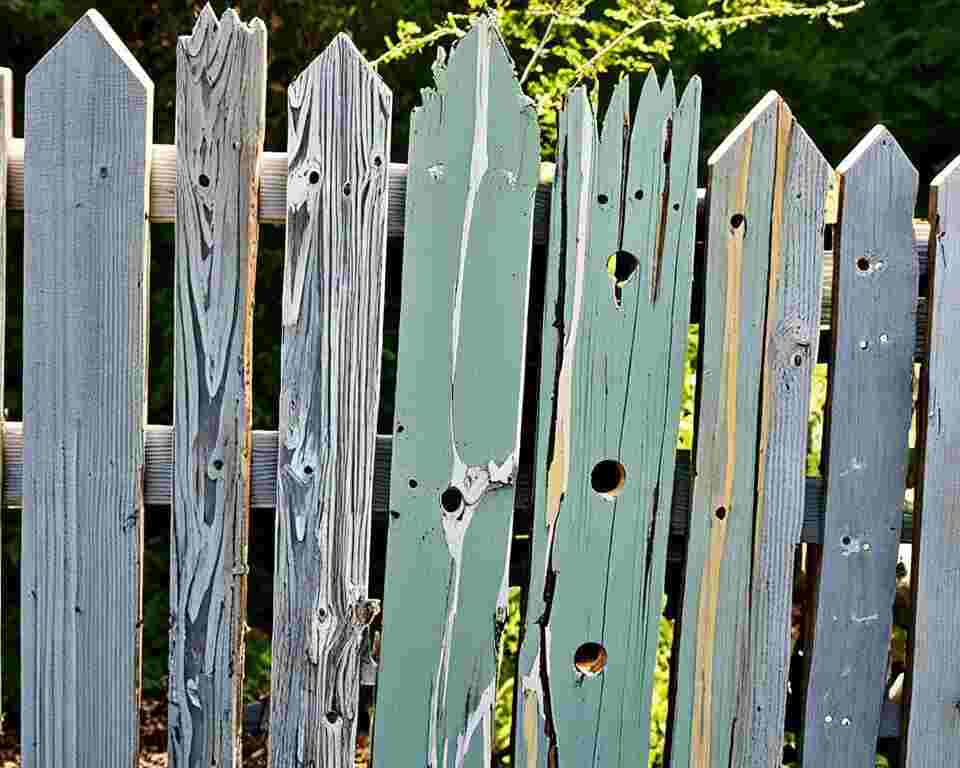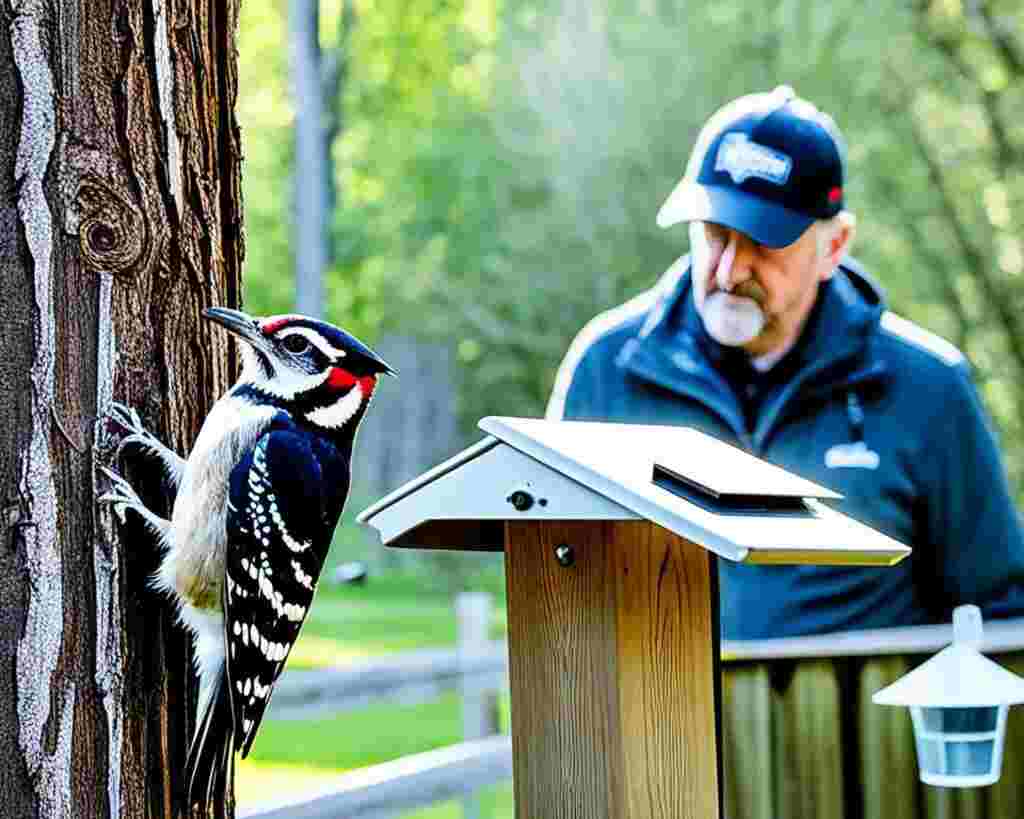Are you dealing with woodpecker damage on your property? These persistent birds can pose a real problem. If you’re seeking solutions, know that you are not alone. Many face this issue, as woodpeckers are known to harm trees and wooden structures. This article aims to provide you with effective strategies for woodpecker removal. Hopefully, these tips will help you restore tranquility to your outdoor spaces.
Understanding woodpecker behavior is crucial before we explore various removal methods. Knowing the reasons behind their pecking can significantly improve your removal efforts. By recognizing the signs of their damage, you are better equipped to protect your property. This knowledge aids in crafting more effective deterrence strategies.
Table of Contents
Key Takeaways:
- Woodpeckers can cause damage to trees and wooden structures
- Understanding woodpecker behavior helps implement better removal strategies
- Recognizing the signs of woodpecker damage is crucial
Understanding Woodpecker Behavior and the Damage They Cause
Woodpeckers are intriguing birds, known for behaviors that can cause issues for homeowners. Learning about these behaviors and the resulting damages can help in formulating strategies to mitigate such problems effectively.
Why Woodpeckers Peck: Identification and Habits
Woodpeckers peck for various reasons, each related to their survival needs. Foraging for insects is a primary reason. With their long, sharp beaks, they drill into trees to find insects under the bark.
They also peck to create nesting cavities, offering shelter for their young. These carved out spaces safe for raising their offspring, are frequently reused.
Marking territory is another reason for their pecking. They drum on resonant surfaces with their beaks, sending clear messages and, during breeding seasons, to avoid disputes with neighbors.
Recognizing and Assessing Woodpecker Damage
The extent of woodpecker damage can vary, depending on the woodpecker species and pecking purpose. Commonly, damage shows as holes or bare patches on trees. These compromised areas can leave trees vulnerable to disease or death.
Wooden structures like siding and fascia boards are also at risk. Mistaking these for trees, woodpeckers can cause noticeable damage, leading to potential structural issues.
Evaluating woodpecker damage involves looking at the pecking’s severity and frequency, plus the risks to trees or structures. Addressing this swiftly can prevent further issues, safeguarding your property’s integrity.

| Signs of Woodpecker Damage | Impact |
|---|---|
| Concentric holes or missing bark on trees | Increased risk of disease and decay |
| Pecking on wooden structures | Potential structural damage |
Protecting Your Home with Woodpecker Deterrents
Woodpeckers can significantly harm your property. Yet, you can effectively safeguard your home. I’ll explore natural woodpecker control strategies here, including both visual and auditory deterrents. Additionally, I’ll discuss how to effectively employ woodpecker deterrent products.
Natural Woodpecker Control: Utilizing Visual and Sound Deterrents
Using visual and sound deterrents is a humane way to keep woodpeckers at bay. An effective technique involves hanging shiny objects, like CDs or aluminum foil strips, in active woodpecker zones. Their reflections and movements deter the birds from pecking.
Moreover, employing scare devices such as plastic owls or snakes proves beneficial. Due to their territorial nature, woodpeckers may hesitate to approach with these decoys in place.
Another method is through auditory deterrents, including wind chimes or bells. Their continuous sound may drive woodpeckers to seek out calmer environments, away from your property.
Effective Woodpecker Deterrent Products and How to Use Them

Beyond natural techniques, the market offers various woodpecker deterrent products. These are crafted to keep woodpeckers away from your grounds effectively.
Bird netting serves as a notable option, perfect for covering at-risk areas such as house sides or eaves. The netting acts as a barrier, blocking woodpeckers from reaching surfaces and inflicting harm.
Another choice is using taste deterrent sprays. These carry a bitter taste that’s off-putting to woodpeckers, keeping them from pecking treated areas. Adhering to the manufacturer’s guidelines for application and reapplication is vital.
Sonic repellers, too, offer a solution by emitting ultrasounds that woodpeckers find disturbing. These devices, simple to install, can protect extensive areas. This makes them both convenient and efficient.
For success with woodpecker deterrents, following the manufacturer’s usage directions is crucial. Each product may have unique application needs or times for reapplication to ensure they work effectively.
By tapping into natural deterrents and potent woodpecker deterrent products, safeguarding your property against woodpecker damage is achievable. This way, the integrity of your home remains intact.
DIY Woodpecker Solutions: Tips for Humane Removal
Looking to tackle woodpecker problems yourself? There are plenty of DIY strategies to explore. They mainly involve distractions to ward off the birds and making home repairs to stop them from coming back.
Creating Distractions to Keep Woodpeckers Away
To keep woodpeckers at bay, consider distractions. This tactic shifts their focus from your home. Here’s how to do it:
- Visual deterrents: Place shiny objects like CDs or aluminum foil strips around pecked areas. Their movement and reflections tend to deter woodpeckers.
- Noise deterrents: Wind chimes or motion-activated sprinklers can scare woodpeckers. The sound and sudden water movement are effective.
- Bird feeders: Offering suet and seed feeders draws woodpeckers away. An alternative food source keeps them off your property.
Shifting deterrents’ positions regularly helps maintain their effectiveness.
Home Repairs That Prevent Woodpecker Damage
Fixing your house is also crucial for woodpecker control. Here are some repair tips:
- Sealing holes and gaps: Look for openings woodpeckers might use for nesting. Seal them with caulking or other materials.
- Protective coverings: Metal flashing or wire mesh can protect vulnerable spots like eaves or siding. This prevents woodpecker damage.
- Repellent sprays: Non-toxic sprays that woodpeckers find unpleasant can keep them away. Apply these to affected areas.
These DIY measures offer a proactive way to deal with woodpeckers. They ensure humane and eco-friendly solutions to the issue.
How to Get Rid of Woodpeckers Using Professional Services
If DIY efforts fall short, seeking professional help is a wise move. Experts in woodpecker control bring targeted skills and methods for humane eviction. Their know-how ensures these persistent birds find a new home, away from yours.
Employing experts grants you access to comprehensive knowledge of woodpecker habits. They can gauge the infestation’s scope and craft a custom eradication strategy. This plan meets your unique situation, offering the most effective solution.
Such professionals commit to the birds’ well-being above all. They’re adept at safe woodpecker handling, assuring relocation to fitting environments. This way, woodpeckers thrive elsewhere, not on your premises.
They also bring in high-end tools and methods to keep woodpeckers at bay. Installation of barriers, like bird netting or spikes, protects your property’s at-risk areas. This prevents further woodpecker visits effectively.
Moreover, they can deploy visual and audio deterrents to make your property less inviting. These measures discourage woodpeckers, prompting them to find other places for food and shelter.
Choosing such services not only saves time but ensures woodpecker removal is done right. You get a durable barrier against future invasions. This defense preserves your trees and wooden assets from damage.
Conclusion
Upon reading this article, you’re now equipped with knowledge on eliminating woodpeckers effectively while safeguarding your property. By applying these strategies, you’ll be able to remove woodpeckers and keep your trees and structures safe.
It’s vital to adopt humane solutions for woodpecker issues. Steer clear of methods that may hurt these birds. Emphasize deterrents, distractions, and fixing homes to deter woodpeckers from damaging.
Should your own attempts fail or if the issue is considerable, consider professional aid. Experts in woodpecker control have the means and knowledge for a safe, effective removal. Don’t be shy to ask for help when it’s necessary.
By heeding the advice on woodpecker removal and prevention of damage, you can achieve a peaceful, woodpecker-free space. Your buildings and greenery will thank you. Take steps now to safeguard your domain from these industrious birds!



